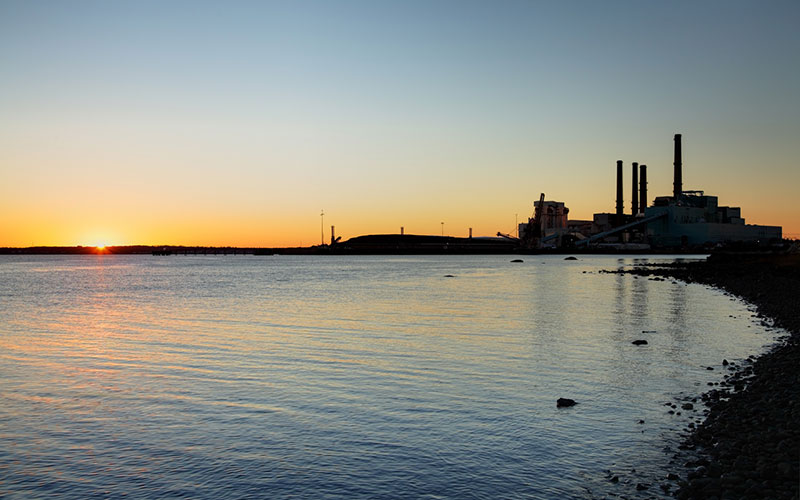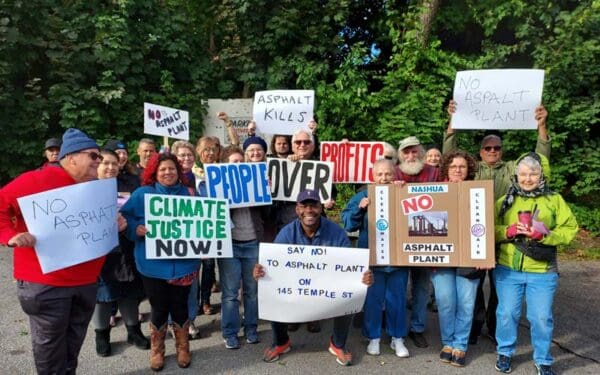
Brayton Point, a shuttered coal plant, sits on a state-designated port area. A proposal to make the site a staging area for offshore wind development shows how these port areas can benefit our clean energy economy and our communities. Photo: IStock
Two proposed projects in Massachusetts aim to transform what were once centers for dirty energy into starting blocks for our clean energy future. In the process, they could provide a blueprint for reimagining our working waterfronts.
Massachusetts’ waterfronts have always played a critical role in the state’s economy, supporting our fishing, shipping, and energy industries, among others. But those industrial uses haven’t always benefitted the communities that host them.
A decade ago, waterfront areas in Salem and Somerset were home to massive coal-burning power plants – two of Massachusetts’ “Filthy Five” dirty energy facilities. For decades, these sites spewed pollution that harmed people’s health, contaminated waterways, and damaged our climate. When they shut down, residents could (literally) breathe a sigh of relief.
Now that those plants are gone, the waterfront land they occupied is poised to help kickstart the state’s green economy, specifically its offshore wind industry. That land is also highlighting the importance of a particular kind of protected land in Massachusetts – designated port areas – and showing how working waterfronts can benefit communities and our environment.
What are Designated Port Areas, and Why Do They Matter?
A designated port area is a state-level restriction on how land is used, limiting that use to commercial and industrial activities that depend on the ocean (for example, commercial fishing, boatyards, and certain energy facilities, among others). Ten sites in Massachusetts currently carry this special designation. These sites are uniquely suited to marine industry because they include land that can house industrial infrastructure, offer deep-water access for commercial ships, and allow for land-based transportation and utilities – for example, the ability to truck in materials – that many industrial uses require.
Questions about these port areas have come up recently, including whether their restrictions should be loosened to allow for development like housing, office buildings, and non-industrial businesses. But once a designated port area is converted to a different use, such as housing, it will no longer be well-suited for water-dependent industries like offshore wind. It’s also unlikely that it could be reverted to that use again.
That would be a loss that Massachusetts can’t afford – especially when it’s on the cusp of the most significant energy transition since the Industrial Revolution. We should therefore protect these designated port areas while striving to strike a better balance on how they’re used.
Proposed Projects Show the Ongoing Value of Designated Port Areas
The proposed clean energy projects in Salem and Somerset could serve as models of that better balance. Both rely on deep-water access – meaning they are feasible only because the Commonwealth has reserved designated port areas for water-dependent industry. And both have the potential to create good, living-wage jobs for local residents without further burdening their neighbors with unhealthy pollution.
In Salem, a developer plans to build an offshore wind “staging area” in its designated port area. Parts and materials for wind turbines will be delivered, assembled, and then transported to an offshore wind farm. Somerset plans to use its designated port area to manufacture cables that transmit the energy from offshore wind turbines to land.
The offshore wind projects these sites will support come at a critical time. Massachusetts’ Global Warming Solutions Act mandates deep cuts in climate-damaging emissions by 2050. These projects will support not only the Commonwealth but other New England states as they aim to do their part in staving off catastrophic levels of warming.
A Chance to Invest in Communities
Just as important, these projects offer economic opportunities for residents of Salem, Somerset, and surrounding communities. Both cities are home to environmental justice populations, and both have borne the health burdens of the dirty energy plants that once loomed over their waterfronts.
Prioritizing skills training and clean energy jobs for these communities – including for workers historically left out of the clean energy industry, such as people of color, women, and people formerly incarcerated – will help correct the longstanding economic and environmental burdens they have endured. It will also set Massachusetts up for success by creating green jobs and expertise that will be in high demand for decades to come.
It’s not just workers who can benefit, however. The Salem and Somerset projects take up only part of the physical space formerly occupied by their respective coal-fired power plants. Those plants – and the health and safety hazards they created – prevented residents from accessing and enjoying those waterfront areas. These new projects offer an opportunity to think about designated port areas as places that can provide communities with more access to the waterfront, rather than cutting them off from it entirely.
Working to Realize the Promise of Designated Port Areas
Salem’s and Somerset’s plans are incomplete, and important details must still be ironed out. For example, state regulators must ensure that these sites’ construction and day-to-day operations won’t negatively impact the surrounding neighborhoods. It’s also vital that the project developers partner with local colleges and job training programs – and commit to prioritizing a local workforce – so that the neighboring communities reap the economic benefits. Moreover, the project developers must ensure that these sites are resilient to climate impacts and provide additional coastal resilience protection on adjacent land.
Still, these projects show how designated port areas can become assets to our economy and our climate. They can center communities that have long deserved to benefit from the industry in their backyards. And they can be hubs of innovation that establish the Commonwealth as a dominant force in growing clean energy and blue tech industries.




